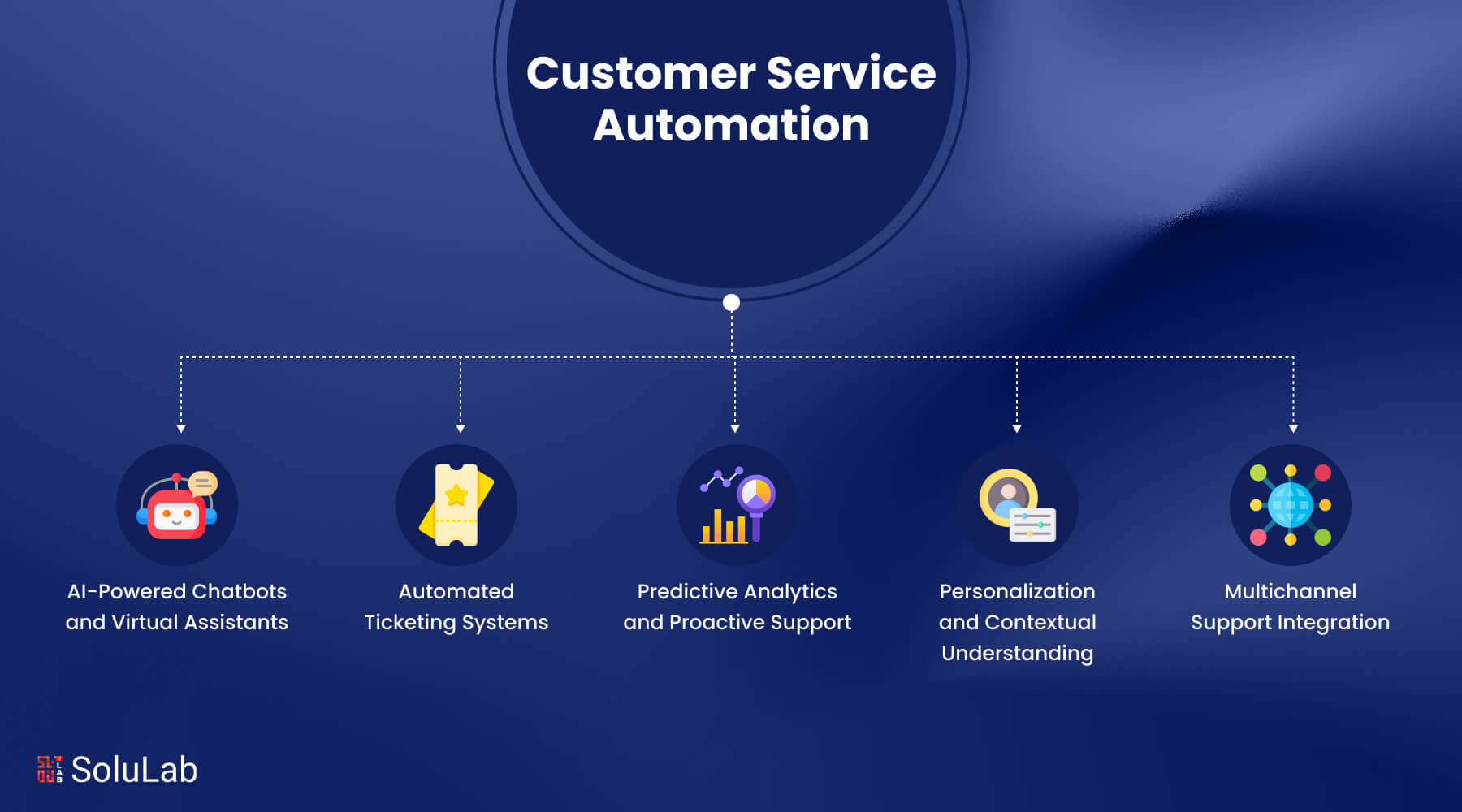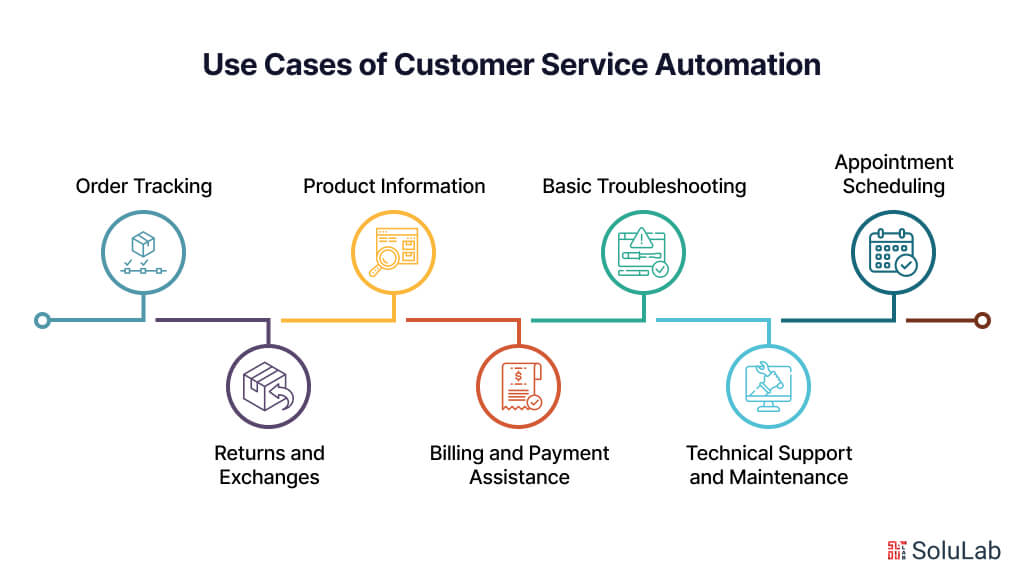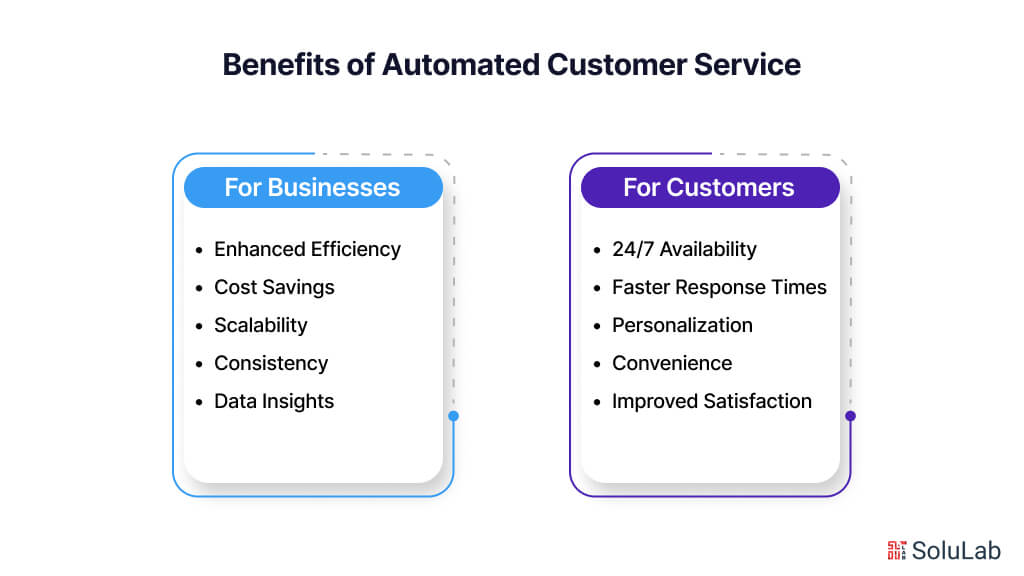
In today’s fast-paced digital world, customer expectations are higher than ever, so prompt and reliable customer service is quite essential. The traditional concept was packed with issues like long waiting times, irregular service, and a strong reliance on manual procedures. These obstacles reduce client satisfaction rate and deplete resources, in addition to decreasing operational efficiency.
| Recent statistics clarify that today’s customers want an instant solution; almost 46% feel that their queries should be answered within 4 hours. Even 12% of them expect a response within 15 minutes. |
Looking for a leading-edge solution, automation in customer service comes out as one of the best resolutions. Businesses may overcome the aforementioned obstacles and raise the bar on customer experiences by opting for automation in their operations, which will promote success, contentment, and loyalty in this digital era.
This blog walks you through customer service automation, its importance, and more. Let’s get started!
What is Customer Service Automation?
Customer service automation is the process of handling customer queries and support tasks by using technology such as chatbots, artificial intelligence, and self-service portals, without the actual need for human interaction.
Earlier, businesses depended on customer support representatives to address problems via email and phone conversations. But when a business expands, so does the demand for more support people, which drives up costs.
Customer service automation is a relatively inexpensive method to expand customer service while maintaining quality. Not just this, it even increases client engagement and helps organizations offer effective, 24/7 customer care.
How Does Customer Service Automation Work?
Customer service automation leverages advanced technologies, particularly artificial intelligence (AI), to streamline and enhance interactions between businesses and their customers. By automating repetitive and time-consuming tasks, companies can improve efficiency, reduce costs, and provide a consistently high level of service. Here’s a look at how customer service automation works:
1. AI-Powered Chatbots and Virtual Assistants
AI-powered chatbots and virtual assistants are the front line of customer service automation. These tools use natural language processing (NLP) and machine learning algorithms to understand and respond to customer queries in real-time. AI in customer service automation can handle a wide range of tasks, from answering frequently asked questions to processing orders and troubleshooting basic issues. Over time, these AI systems learn from interactions, becoming more accurate and effective in their responses.
2. Automated Ticketing Systems
Automated ticketing systems streamline the process of managing customer inquiries. When a customer submits a query, the system automatically categorizes and prioritizes the ticket based on the nature of the request. AI algorithms analyze the content to determine the best course of action, whether it’s routing the ticket to the appropriate department or suggesting automated responses. This ensures that urgent issues are addressed promptly and routine queries are handled efficiently.
3. Predictive Analytics and Proactive Support
AI in customer service automation also extends to predictive analytics and proactive support. By analyzing historical data and customer behavior patterns, AI can predict potential issues before they arise. For instance, if a product is likely to fail after a certain period, the system can proactively reach out to customers with maintenance tips or offer a replacement. This proactive approach not only improves customer satisfaction but also helps in reducing the volume of incoming support requests.
Related: Generative AI Automation
4. Personalization and Contextual Understanding
One of the key advantages of AI in customer service automation is its ability to deliver personalized experiences. AI systems can integrate with customer relationship management (CRM) platforms to access a wealth of customer data, including previous interactions, purchase history, and preferences. This enables the system to provide contextually relevant responses and recommendations, making interactions more meaningful and tailored to individual needs.
5. Multichannel Support Integration
Modern customer service automation systems are designed to work seamlessly across multiple communication channels, including email, live chat, social media, and phone. AI ensures that customers receive a consistent experience regardless of the channel they use. For example, a customer can start an interaction on social media and continue it via email without having to repeat information, as the AI system maintains continuity across channels.
Use Cases of Customer Service Automation

There are several ways in automating customer service to meet customer needs effectively. Here are some key use cases:
1. Order Tracking
Automating order tracking allows customers to access real-time updates on their delivery status and estimated arrival times. Automated notifications via email or SMS keep customers informed throughout the delivery process, enhancing transparency and reducing the need for manual inquiries.
This automation not only boosts operational efficiency by reducing customer support requests but also builds customer confidence through visibility into their order’s progress, thereby enhancing the overall purchasing experience and fostering brand loyalty.
2. Appointment Scheduling
AI-driven appointment scheduling simplifies the booking process by enabling customers to book appointments online with ease. By providing real-time availability, customers can select convenient time slots without needing to coordinate manually.
This customer care automation reduces administrative tasks for businesses, freeing up staff for other responsibilities. Also, automated systems can send confirmations and reminders, reducing no-show rates and improving efficiency. Ultimately, this provides a seamless and convenient booking experience, enhancing customer satisfaction.
3. Basic Troubleshooting
Virtual assistants, as interactive self-service tools, help customers resolve common issues on their own. By analyzing customer queries, these automated systems offer step-by-step instructions, troubleshooting tips, and solutions tailored to specific problems.
Empowering customers with self-service options reduces the volume of support requests, lessens the burden on support teams, and increases customer satisfaction by enabling quick resolution of issues. These tools also contribute to a more efficient support process and foster customer empowerment and self-reliance.
Related Blog: A Guide to AI Workflow Automation
4. Product Information
Automating access to comprehensive product information through self-service portals or chatbots allows customers to instantly obtain detailed specifications, usage guidelines, and troubleshooting tips.
This enables customers to make informed purchasing decisions at their convenience without needing human assistance. Ultimately, it allows for a higher and quicker decision-making process, increasing the customer retention rate too.
5. Returns and Exchanges
Automating the returns and exchanges process involves providing customers with pre-filled forms, shipping labels, and clear return instructions. This streamlines the entire process from initiation to completion, significantly reducing administrative overhead and manual labor.
Simplifying the returns process enhances customer satisfaction by reducing friction and offering a hassle-free experience. Customers appreciate the convenience, resulting in a more positive perception of the brand and an increased likelihood of repeat purchases.
6. Billing and Payment Assistance
Automated billing and payment assistance systems handle inquiries related to payments and billing support autonomously. These systems can address common billing questions, securely process payments, and resolve issues like invoice discrepancies or payment errors.
By automating these tasks, businesses improve efficiency and accuracy in financial transactions, reduce manual intervention, and enhance the overall customer experience. Moreover, automated systems offer 24/7 availability, ensuring customers can access billing and payment assistance whenever needed, leading to higher customer satisfaction and loyalty.
7. Technical Support and Maintenance
Automated technical support systems utilize AI-powered diagnostic tools to remotely identify and troubleshoot common technical issues. These systems analyze error codes, log files, and system configurations to pinpoint root causes and recommend real-time solutions.
Automating this process allows businesses to swiftly resolve issues without manual intervention, minimizing downtime and ensuring uninterrupted service delivery.
All in all, incorporating these methods of automating customer service helps businesses streamline their day to day operations, improve efficiency, and enhance the customer experience.
What are the Advantages of Automated Customer Service?

AI in customer service automation offers numerous advantages for both businesses and customers. Here are the key benefits of automation in customer service:
A. For Businesses
- Enhanced Efficiency
Automation in customer service streamlines workflows by managing routine tasks such as answering FAQs, processing orders, and scheduling appointments. This efficiency allows employees to focus on higher-value activities like problem-solving, innovation, and strategic planning, thereby boosting productivity and driving business growth.
- Cost Savings
By automating repetitive customer service tasks, businesses can significantly cut labor costs associated with hiring and training customer support staff. Moreover, AI automation reduces the risk of human error, decreasing the need for expensive corrective actions and enhancing overall operational efficiency. According to McKinsey, automation can reduce costs by 20-40%.
- Scalability
AI-powered customer service automation provides scalability, allowing businesses to manage increasing customer inquiries without needing additional human resources. Automated systems can adjust to fluctuations in customer demand, ensuring consistent service quality and customer satisfaction.
- Consistency
AI-driven automation ensures consistent service across all customer interactions, regardless of time or day. Automated systems adhere to predefined rules and protocols, maintaining brand integrity and upholding service standards, which fosters customer trust and loyalty.
- Data Insights
Customer service automation powered by AI collects and analyzes vast amounts of customer data in real time. This sophisticated analytics capability enables businesses to extract valuable insights into customer behavior, preferences, and emerging trends. These insights inform strategic decision-making, product development, and marketing initiatives, helping businesses stay competitive and meet evolving customer needs effectively.
B. For Customers
- 24/7 Availability
AI-powered automation ensures customers have access to support and assistance around the clock, eliminating the frustration of waiting for business hours. Whether late at night or early in the morning, customers can rely on automated systems for timely help whenever they need it.
- Faster Response Times
Automated systems respond to customer inquiries and resolve issues instantly, avoiding delays common with human-based support. Utilizing natural language processing (NLP) and machine learning, AI automation accurately interprets customer queries and provides relevant responses or solutions in real time, leading to faster resolution and improved customer satisfaction.
- Personalization
AI-powered automation enables businesses to deliver personalized customer experiences by analyzing individual preferences, purchase history, and browsing behavior. Automated systems use this data to tailor responses, suggestions, and promotions to each customer, creating more engaging and relevant interactions.
- Convenience
Customers can interact with businesses through their preferred channels, such as email, chat, phone, or social media. AI-driven automation ensures a seamless omnichannel experience, allowing customers to switch between channels effortlessly while retaining context, thus avoiding the need to repeat information. This convenience enhances the overall customer experience, promoting engagement and loyalty.
- Improved Satisfaction
AI-powered automation boosts customer satisfaction and loyalty by providing timely, accurate, and personalized support. Customers appreciate the convenience, efficiency, and consistency of automated systems, leading to higher trust and loyalty toward the business. Consequently, businesses benefit from increased customer retention, positive word-of-mouth, and sustainable long-term growth.
How Can AI be Used to Automate Customer Service?
There are many crucial elements involved in integrating AI into customer service automation:
- Determine the Use Cases: Ascertain which customer service procedures stand to gain the most from AI and automation. Predictive analytics for proactive assistance, sentiment analysis for feedback management, and chatbots for simple questions are examples of common use cases.
- Gathering and Preparing Data: Collect pertinent information from a range of sources, including transaction history, client interactions, and feedback. To guarantee the quality and purity of the data, clean, arrange, and get it ready for analysis.
- Select the Appropriate AI Technologies: Choose AI solutions that support your company goals and use cases. This might involve sentiment analysis, machine learning for predictive analytics, and natural language processing (NLP) for chatbots.
- Create AI Models: Using the data you have already prepared, create and train AI models. This entails using previous chat logs to train NLP models for chatbots. Use historical consumer behavior to train machine learning models for predictive analytics, which forecast future results.
- Connectivity With Systems for Customer Service: Include AI technology into the channels and systems you now use for customer support. This might entail incorporating sentiment analysis tools into your feedback management platform, embedding predictive analytics into your CRM system, and adding chatbots to your website or messaging services.
- Optimization and Testing: To make sure your AI-powered customer care automation solutions function as intended, test them in actual customer service situations. To find areas for improvement, keep an eye on performance and solicit user input.
- Scaling and Deployment: Introduce your AI-driven customer support automation systems into real-world settings. As usage increases, keep an eye on performance and scalability and make necessary adjustments to guarantee peak performance and client satisfaction.
- Instruction and Assistance: To guarantee that consumers and customer care representatives know how to communicate with AI-powered systems, give them assistance and training. Keep them informed about new features and best practices by providing continual training and assistance.
These guidelines can help businesses successfully integrate AI into customer service automation, increasing productivity, boosting client satisfaction, and fostering corporate success.
How Does SoluLab Help With Customer Service Automation?
Automation of customer service marks a significant change in the way companies interact with their clients, solving long-standing problems and bringing in a new era of efficacy and efficiency.
SoluLab, as a top AI development company, helps organizations automate routine tasks and provide personalized support to customers. We assist in integrating innovative customer service automation solutions such as AI-powered chatbots, predictive analytics, and sentiment analysis tools. This allows companies to improve operational efficiency, reduce response times, and ensure consistent service delivery.
SoluLab’s expertise in AI integration solutions makes it a leading name within the industry. There are multiple business projects that we have assisted with by integrating AI-powered chatbots within the business operations. If you also wish to speed up your customer service, our seasoned experts are all set to cater to your specific needs.
Still in doubt? Get in touch with the industry experts NOW!
FAQs
1. What is customer service automation?
Customer service automation involves using technology like AI and machine learning to handle customer inquiries and support tasks without human intervention. This can include automated responses, chatbots, virtual assistants, and ticketing systems, all designed to improve efficiency and enhance the customer experience.
2. What are the benefits of customer service automation?
Customer service automation provides 24/7 support, faster response times, and cost efficiency by reducing the need for a large support team. It also ensures consistent and accurate responses to customer inquiries and allows businesses to handle high volumes of requests without compromising service quality.
3. How does customer service automation improve customer satisfaction?
Automation improves customer satisfaction by delivering timely and accurate responses, reducing wait times, and efficiently handling multiple inquiries simultaneously. By routing complex issues to human agents when necessary, it ensures customers receive appropriate and swift assistance, leading to a better overall experience.
4. Can automated customer service systems handle complex issues?
Automated systems can manage a variety of inquiries, including some complex issues. For highly complex or sensitive matters, automation gathers initial information and then escalates the issue to human agents, ensuring customers receive the necessary detailed and personalized help without delays.
5. What are some common tools used in customer service automation?
Common tools include chatbots for real-time interaction, virtual assistants for personalized responses, automated ticketing systems for efficient issue tracking, interactive voice response (IVR) systems for telephony support, and email automation for timely communication and follow-ups. These tools streamline processes and enhance customer satisfaction.






